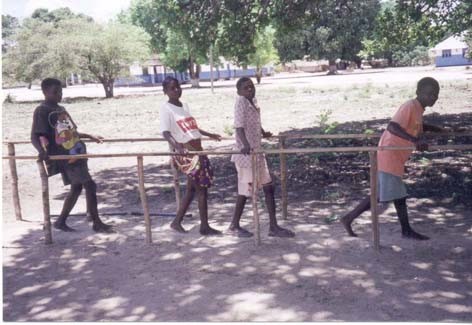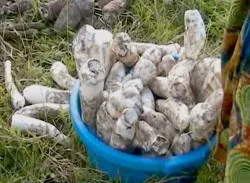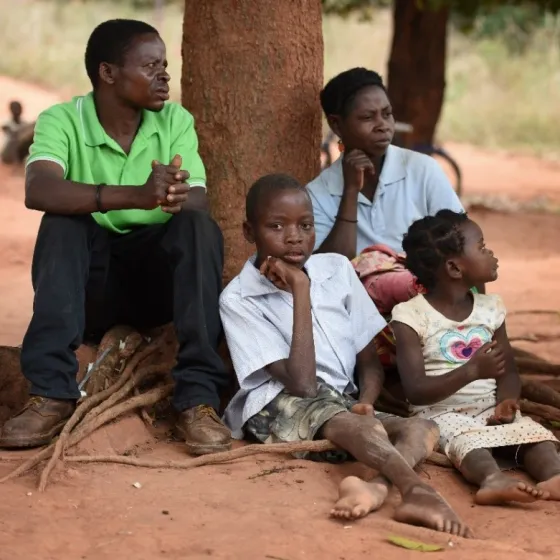Konzo and Cassava
Konzo

Konzo is an upper motor neuron disease that causes irreversible paralysis of the legs and occurs mainly in children and young women of child-bearing age. The paralysis occurs quite suddenly, does not progress over time and is irreversible. It is associated with the consumption of a monotonous diet of high cyanide (bitter) cassava, by poor rural people in Africa, many of whom suffer from malnutrition. Specifically, konzo is associated with a high cyanide diet of bitter cassava consumed over a period of several weeks combined with a low intake of protein, particularly a shortfall of essential S-containing amino acids that are needed to detoxify cyanide to thiocyanate in the body.
Konzo occurs in the Democratic Republic of Congo (DRC), Mozambique, Tanzania, Cameroon, Central African Republic and Angola. The incidence of konzo is greatest in the DRC; the total number of cases is unknown but one estimate is 100,000 cases. Konzo epidemics occur during drought when the cassava plant is stressed and produces much larger amounts of cyanide compounds (cyanogens) than usual and also as a result of war when people are displaced from their homes and forced to eat bitter unprocessed cassava from the bush (see Publications No. 11). Konzo was first reported by Dr Trolli, in the then Belgian Congo in 1938, in Popokabaka Health Zone in Bandundu Province and we have prevented konzo for the first time ever in the same Health Zone (see Publications No. 7).
In all our studies in DRC we find that konzo has increased greatly since 2009, due to smaller amounts of cassava being grown, which has resulted in short-soaking of cassava roots for only 1-2 days, instead of the 3-4 days required to completely remove cyanogens from the root.
Other cyanide-related diseases
Tropical ataxic neuropathy (TAN) is a condition that has been known for more than a century and occurs in many countries of Africa, the West Indies and India (see Madhusudanan et al., CCDN News No 11, p3). It is a chronic condition of gradual or insidious onset, which is commonest amongst poor people in their 50's and 60's and is rare in children under 10. Patients are usually poor and consume a monotonous cassava diet. Symptoms include loss of sensation in hands, a sensation of something smeared on the soles of the feet which cannot be removed by trying to wipe it off, loss of vision, ataxia of gait, deafness, weakness and thinning of the legs. The disease is persistent in Nigeria and its incidence can be up to 18-26 persons per 1000 in villages where the diet is nearly all cassava. By comparison in yam-eating villages there is no incidence of TAN. It was considered that TAN was due solely to chronic cyanide intoxication but studies by Rosling and coworkers have shown that the situation may be more complex. By contrast konzo is due to acute cyanide exposure and levels of blood cyanide in konzo patients were found to be about 20 times as high as those in TAN patients. The onset of TAN is usually slow over months or years, whereas the onset of konzo is abrupt and its course is non-progressive. The mean age of people affected by TAN is greater than 40 years whereas konzo is primarily a disease of children and young women.
Cyanide poisoning Cyanide binds to an enzyme called cytochrome oxidase and stops its action in respiration, which is the key energy conversion process in the body. The lethal dose of cyanide for an adult depends on body weight and is between 30 and 210 mg of hydrogen cyanide. Sometimes these limits are exceeded by persons eating a cassava meal and deaths occur due to cyanide poisoning. Smaller (non-fatal) amounts of cyanide cause acute intoxication with symptoms of dizziness, headache, nausea, stomach pains, vomiting and diarrhoea.
Goitre and cretinism Low dietary intake of iodine causes insufficient production of iodine-containing hormones in the thyroid gland and this produces goitre (enlargement of the thyroid gland) and cretinism (shortness of stature and severe mental impairment). Iodine deficiency disorders, including goitre and cretinism, are a major global health problem that affects about 500 million people. Ingested cyanide from cassava consumption is converted in the body to thiocyanate and is removed in the urine. The thiocyanate is a goitrogen, because it inhibits the uptake of iodine by the thyroid gland. Cyanide intake from cassava consumption thereby aggravates goitre and cretinism, but only if the iodine supply is below the recommended daily intake. Thus the effect of cassava in exacerbating goitre and cretinism may be corrected by increasing the intake of iodine.
Impaired neurocognition Boivin et al., Pediatrics 2013, 131, have shown that children with konzo have impaired motor proficiency skills and impaired neurocognition compared with control children from a non-konzo area. This may extend the human burden of konzo with important public health implications.
Cassava

Cassava is the third most important food source in the tropics and the staple food of tropical Africa. It originated in Brazil and was introduced into Africa many hundreds of years ago. Its production over 24 African countries has increased threefold from 1980 to 2005 (compared with a 42% increase for Indonesia) and the population in Africa has doubled compared with a 50% increase worldwide (see Publications No. 11). Cassava is a hardy, drought resistant crop that gives acceptable yields on low-fertility soils and is of great importance for subsistence farmers throughout the tropics. In some countries such as Thailand it is also grown in plantations to produce starch and pellets for animal feed, much of which is exported to developed countries.
Cassava roots are very starchy and their protein content is less than that of other tropical root crops such as yam, sweet potato, and taro. Cassava contains the cyanogenic glucoside linamarin and a small amount of lotaustralin (methyl linamarin) both of which are broken down to cyanohydrins and glucose, catalysed by the enzyme linamarase also present in the root. The cyanohydrins readily break down to hydrogen cyanide in neutral or alkaline conditions.

The cassava plant has a large amount of linamarin in the leaves and in the skin of the root. Sweet cassava has a small amount of linamarin in the inner part of the root called the parenchyma and bitter cassava has a much larger amount. The bitter taste is mainly due to linamarin but there are other bitter compounds in the root and also sour constituents, which sometimes confuses the taste buds (see Publications No. 20). The total cyanide content of the parenchyma of different cassava varieties ranges from 1 mg HCN equivalents / kg fresh root (1 ppm) to 1550 ppm. In Nigeria one variety is called "chop and die". The parenchyma from sweet cassava is cooked and eaten whereas that from medium and high cyanide cassava must be processed into products such as flour and gari. Cassava leaves are used widely in tropical Africa. They are a good source of protein and vitamins but contain large amounts of linamarin that is traditionally removed by pounding followed by boiling in water (see Mild Method).
Traditional methods of processing cassava roots
Cassava roots are the most perishable of the major root crops and deteriorate in air at ambient temperature in a few days. In subsistence agriculture the plants are left in the ground until needed for food or for processing. The twin problems of perishability and the poisonous nature of the cyanogens present in cassava roots have been partly overcome by development of a large number of traditional forms of processing in different parts of the world. In East Africa cassava flour is preferred, whilst in West Africa a roasted product called gari is most commonly produced. In South and Central America there are many different cassava products. In the South Pacific, where the introduced cassava varieties are virtually all sweet (low cyanide), the roots after peeling are boiled and eaten. In Eastern and Central Africa where cassava flour is made by sun drying and heap fermentation the retention of cyanide is about ten times that of gari and farinha. The situation is made much worse in drought years which are a normal feature of the climate, when water stress on the cassava plant causes a large increase of the cyanide content of the roots. We have developed a simple wetting method (see Publications No. 8) for removing cyanide from flour and have used this to control konzo in many villages in DRC (see Publications Nos. 6, 21 and 22).
There are many traditional processing methods used around the world, but we will limit discussion to the major methods used in Africa.
- Sun-drying In East Africa the simplest method is sun drying. This involves peeling the roots followed by sun drying of intact roots, or large pieces cut longitudinally. The brittle, dry material is then pounded in a wooden pestle and mortar and sieved to remove fibrous material to produce a white flour. The amount of cyanide retained as linamarin is quite high at 25-33%.
- Heap fermentation involves peeling and cutting the roots and leaving them in a small heap for 3-5 days during which some fermentation takes place with liberation of hydrogen cyanide. The roots are then sun dried, pounded and sieved as already described. Flour produced by heap fermentation is slightly dark coloured and the retention of cyanide is 12.5-16.5% (see Publications No. 14). In times of drought when the total cyanide content of roots increases 2-4 times, heap fermentation is preferred by women processors over sun drying (see Publications No. 16).
- Steeped in water In Central Africa where there is sufficient water, whole peeled roots are steeped in water for 3 days and the softened tissue is sun dried, pounded and sieved to produce a low cyanide flour. However sometimes roots are immersed for only 1-2 days and converted into flour which still retain large amounts of cyanogens.
- Gari The amount of reaction between linamarin and the enzyme linamarase to produce cyanohydrins which break down to liberate hydrogen cyanide is increased greatly by grating or crushing to give small pieces of cassava root. In the production of gari in West Africa, the grated cassava is stored in a bag for 2-3 days. The excess water is then squeezed out in a press, the damp product is dried and hydrogen cyanide removed by roasting in a metal dish over a wood fire. The retention of cyanide in gari is only 1.8-2.4 % (see Publications No. 14), but is still sufficient to cause TAN amongst some poor people in Nigeria. We have developed a simple method to reduce by about one half the total cyanide content of gari (see Publications No. 9).
Living with konzo
‘I didn’t know eating cassava could be so dangerous’ Fatima Colher, Mozambique 2018

Fatima (25) is a young mother with big worries. Her three children (8, 6 and 1) are seriously undernourished, but she is hardly able to feed them. ‘Our tiny plot doesn’t yield enough. Moreover, cooking and fetching water is very difficult, because I can hardly walk. Both my legs were suddenly paralysed after having eaten cassava that was insufficiently detoxified. I really don’t know what to do.’
‘Our family depends on cassava. It's our basic food. We eat it every day. It’s a crop that is drought-resistant and grows all year round. I didn’t know that eating cassava could have such dangerous consequences though. I now know that from experience. By preparing it the wrong way I have swallowed too much hydrocyanic acid, causing my legs to be permanently crippled. Konzo, that’s what this cassava disease is called. Working the land, fetching water and cooking; all these thing I can barely manage due to my disabilities. My husband Luciano (35) had left me, because he said I could no longer be a good wife, yet he came back.’
‘Apart from cassava, we hardly have anything to eat. We only eat a little every day and fight against hunger. It breaks my heart to see my children suffer this much. It’s very dangerous for them to be underfed; they are weak and get ill more quickly. I fear that they’ll become paraplegics through konzo as well. Fortunately, a local volunteer will teach us various methods to remove the poisonous hydrocyanic acid from the cassava. But I’ll also have to make sure my children will get high-protein food; I’m all too aware of that. How to get hold of that though… The other day I boiled an egg and we shared it between the five of us. To us, that is quite something.
As for myself, I need all the vitamins I can get, as I’m breastfeeding our youngest. I recently started getting multivitamins, which I take diligently. The nutrients in my milk are very important for my baby’s growth. Hopefully he will get stronger soon.
We'd never have guessed cassava was the culprit.’ Andolinho and Esmeralda, Mozambique 2018

Both Andolinho (12) and his younger sister Esmeralda (6) suddenly became paraplegic. Their parents were at their wits’ end. How on earth could this have happened? That cassava was to blame, they never would have guessed.
‘My wife Lucia (28) and I took our children to the local health centre,’ says their father Janvahio (32). ‘We wanted to find out what had brought on the paralysis in the lower part of their bodies. Unfortunately, the doctor couldn’t help us and referred us to the district hospital. We never went there in the end. Not because we didn’t want to, but it’s too far to walk and we didn’t have enough money to pay the bus fare. We were on our own then and didn’t get any help.’
‘Eventually we discovered that our children have become permanently paralysed from eating insufficiently detoxified bitter cassava. They got too much hydrocyanic acid into their system. Our one-sided diet consisted mainly of cassava. We ate both the roots and the leaves. If only we’d have known to first detoxify the cassava. Because we didn’t prepare our food properly, our children now suffer from the crippling disease konzo. Konzo cannot be treated. Prevention is the only option. In a special training we were taught various methods to remove the toxin from the roots and leaves. We now follow these methods. Unfortunately, Andolinho and Esmeralda will never regain their health however. Their paralysis is irreversible.’
‘I realise only too well that our son will never walk again. I’m very grateful he will soon get a wheelchair. That’ll make us much more mobile. I still have hopes for my daughter though: I think that with an intensive rehabilitation programme she will learn how to walk again. That is my biggest wish. Because if she can walk, she can go to school'.
